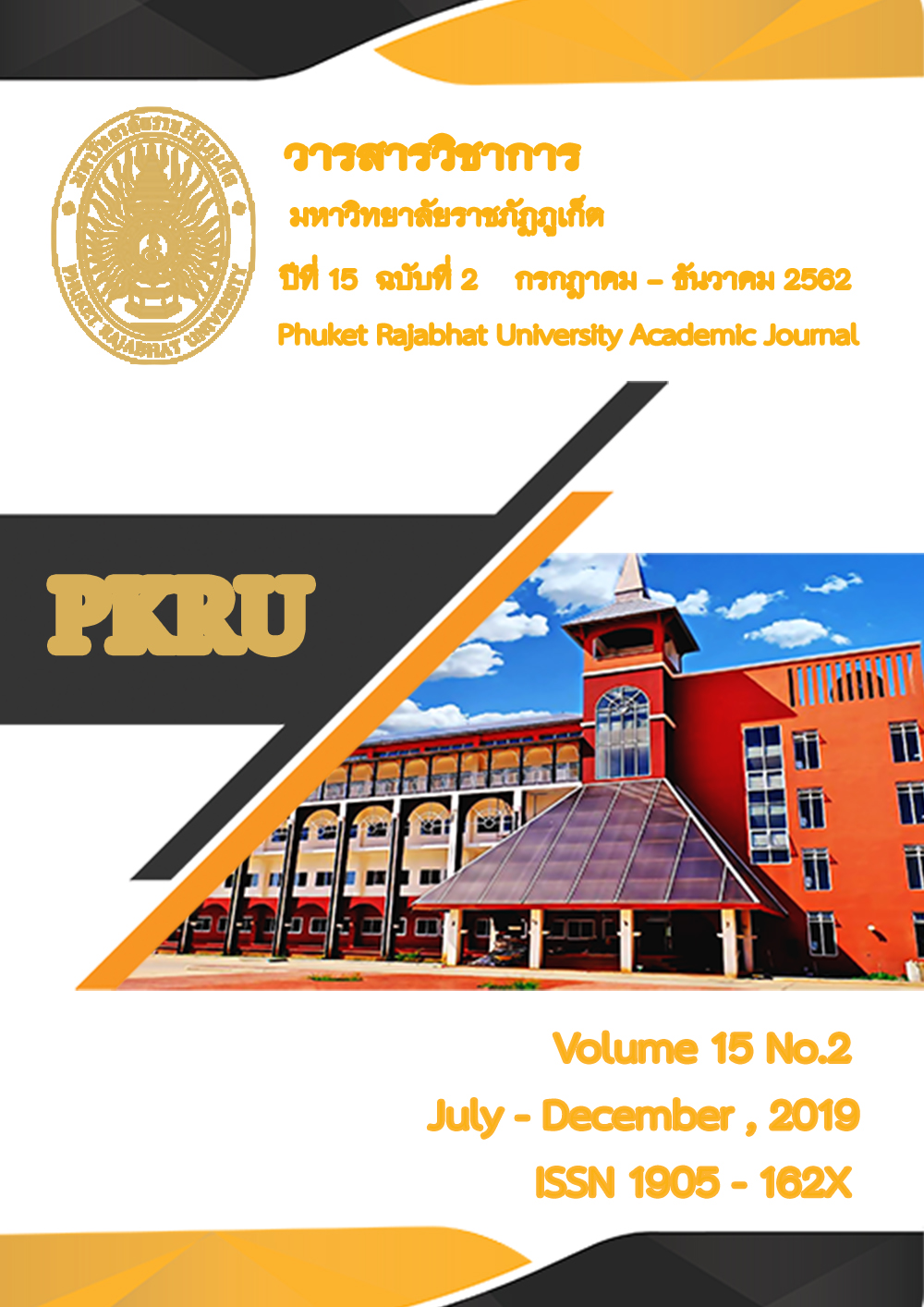ศักยภาพการจัดการท่าเรือแหลมฉบังเพื่อส่งเสริมการท่องเที่ยวเรือสำราญของประเทศไทย
Main Article Content
บทคัดย่อ
การศึกษาครั้งนี้มีวัตถุประสงค์เพื่อประเมินศักยภาพการจัดการท่าเรือแหลมฉบังเพื่อการท่องเที่ยวเรือสำราญ โดยใช้ระเบียบวิธีวิจัยเชิงปริมาณ เก็บข้อมูลด้วยแบบสอบถามจากนักท่องเที่ยวชาวต่างชาติที่เดินทางมากับเรือสำราญและใช้บริการท่าเรือสำราญ ณ ท่าเรือแหลมฉบัง รวมถึงมีการท่องเที่ยวบนฝั่ง จำนวน 400 คน โดยใช้การสุ่มตัวอย่างแบบบังเอิญ (Accidental Sampling) สถิติที่ใช้ในการวิเคราะห์ข้อมูล ได้แก่ ค่าเฉลี่ย ส่วนเบี่ยงเบนมาตรฐาน และสถิติทดสอบค่าที (t-test) ผลการวิจัย พบว่า ภาพรวมมีระดับความสำคัญของความคาดหวังในระดับมากที่สุดและมาก และมีศักยภาพการปฎิบัติงานอยู่ในระดับมาก ในแต่ละด้านพบว่าปัจจัยของสภาพอากาศและทะเล มีศักยภาพผลการปฏิบัติงานระดับมากที่สุด รองลงมาคือ พิธีการตรวจคนเข้าเมือง และการเดินทางเชื่อมต่อกับท่าเรืออื่น ๆ ส่วนศักยภาพผลการปฏิบัติงานน้อยที่สุด คือ การเข้าถึงและการเชื่อมต่อจากท่าเรือสู่เมือง รองลงมาคือ การบริการอินเตอร์เน็ตและโทรศัพท์ การเข้าถึงและการเชื่อมต่อจากท่าเรือสู่แหล่งท่องเที่ยว ตามลำดับ
Article Details
เนื้อหาและข้อมูลในบทความที่ลงตีพิมพ์ในวารสารวิชาการมหาวิทยาลัยราชภัฏภูเก็ต ถือเป็นข้อคิดเห็นและความรับผิดชอบของผู้เขียนบทความโดยตรง ซึ่งกองบรรณาธิการวารสารฯ ไม่จำเป็นต้องเห็นด้วยหรือร่วมรับผิดชอบใด ๆ
บทความ ข้อมูล เนื้อหา รูปภาพ ฯลฯ ที่ได้รับการตีพิมพ์ในวารสารวิชาการมหาวิทยาลัยราชภัฏภูเก็ต ถือเป็นลิขสิทธิ์ของวารสารวิชาการมหาวิทยาลัยราชภัฏภูเก็ต หากบุคคลหรือหน่วยงานใดต้องการนำทั้งหมดหรือส่วนหนึ่งส่วนใดไปเผยแพร่ต่อหรือเพื่อกระทำการใด ๆ จะต้องได้รับอนุญาตเป็นลายลักษณ์อักษรจากวารสารวิชาการมหาวิทยาลัยราชภัฏภูเก็ตก่อนเท่านั้น
เอกสารอ้างอิง
Bowen, C., Fidgeon, P., & Page, S. J. (2014). Maritime tourism and terrorism: customer perceptions of the potential terrorist threat to cruise shipping. Current Issues in Tourism, 17(7), 610-639.
Chang, Y.-T., Liu, S.-M., Park, H., & Roh, Y. (2016). Cruise traveler satisfaction at a port of call. Maritime Policy & Management, 43(4), 483-494.
Chen, C.-A. (2016). How can Taiwan create a niche in Asia's cruise tourism industry?Tourism Management, 55, 173-183.
Chul-Ho, C., Byung-Il, K., & Jae-Hoon, H. (2010). A comparative analysis of the ports of Incheon and Shanghai: The cognitive service quality of ports, customer satisfaction, and post-behaviour. Total Quality Management & Business Excellence, 21(9), 919-930.
CLIA. (2015). Asia Cruise Trends.
CLIA. (2016). Asia Cruise Trends.
Denktas-Sakar, G., & Karatas-Cetin, C. (2012). Port Sustainability and Stakeholder Management in Supply Chains: A Framework on Resource Dependence Theory. The Asian Journal of Shipping and Logistics, 28(3), 301-319.
Douglas, N., & Douglas, N. (2004). Cruise ship passenger spending patterns in Pacific island ports. International Journal of Tourism Research, 6(4), 251-261.
Gibson, P. (2012). Cruise Operations Management: Hospitality Perspectives: Routledge.
Hull, J. S., & Losekoot, E. (2011). Customer orientation of cruise destinations in Newfoundland and Labrador, Canada–exploring key issues for ports and the cruise lines. Turizam: znanstveno-stručni časopis, 60(1), 71-90.
Lekakou, M. B., Pallis, A. A., & Vaggelas, G. K. (2009). Which homeport in Europe: The cruise industry’s selection criteria. Tourismos: An international multidisciplinary journal of tourism, 4(4), 215-240.
Lois, P., Wang, J., Wall, A., & Ruxton, T. (2004). Formal safety assessment of cruise ships. Tourism Management, 25(1), 93-109.
Monpanthong, P. (2015). Cruise Tourism Development within Thailand: Tourism Authority of Thailand.
Monpanthong, P., & Choibamroong, T. (2015). Performance of Phuket's Port of Call Management for Cruise Tourism: an Assessment of IPA Application. WMS Journal of Management, 4(1), 1-11.
Pallis, A. A., Vitsounis, T. K., De Langen, P. W., & Notteboom, T. E. (2011). Port Economics, Policy and Management: Content Classification and Survey. Transport Reviews, 31(4), 445-471.
Pallis, T. (2015). Cruise Shipping and Urban Development. University of Aegean.
PATA. (2011). The Cruise Industry in Asia and Pacific : Issues and Trends.
Perucic, D. (2007). THE IMPACT OF GLOBALIZATION ON SUPPLY AND DEMAND IN THE CRUISE INDUSTRY. Tourism & Hospitality Management, 13(3), 665-680.
Ramkissoon, H., & Nunkoo, R. (2011). City Image and Perceived Tourism Impact: Evidence from Port Louis, Mauritius. International Journal of Hospitality & Tourism Administration, 12(2), 123-143.
Sanz Blas, S., & Carvajal-Trujillo, E. (2014). Cruise passengers' experiences in a Mediterranean port of call. The case study of Valencia. Ocean & Coastal Management, 102, Part A, 307-316.
Satta, G., Parola, F., Penco, L., & Persico, L. (2015). Word of mouth and satisfaction in cruise port destinations. Tourism Geographies, 17(1), 54-75.
Sun, X., Feng, X., & Gauri, D. K. (2014). The cruise industry in China: Efforts, progress and challenges. International Journal of Hospitality Management, 42, 71-84.
Thurau, B., Seekamp, E., Carver, A. D., & Lee, J. G. (2015). Should Cruise Ports Market Ecotourism? A Comparative Analysis of Passenger Spending Expectations within the Panama Canal Watershed. International Journal of Tourism Research, 17(1), 45-53.
UNWTO. (2012). Cruise Tourism - Current Situation and Trends in Asia and the Pacific Asia Pacific Newsletter 28-31.
UNWTO. (2016). Sustainable Cruise Tourism Development Strategies
Wang, Y., Jung, K.-A., Yeo, G.-T., & Chou, C.-C. (2014). Selecting a cruise port of call location using the fuzzy-AHP method: A case study in East Asia. Tourism Management, 42, 262-270.
Yamane, T. (1973). Statistics: an introduction analysis. Harper & Row.
Yi, S., Day, J., & Cai, L. A. (2014). Exploring Tourist Perceived Value: An Investigation of Asian Cruise Tourists' Travel Experience. Journal of Quality Assurance in Hospitality & Tourism, 15(1), 63-77.
ไพฑูรย์ มนต์พานทอง. (2015). การท่องเที่ยวเรือสำราญ กับความท้าทายของประเทศไทย. TAT Review Magazine 1, 45-59.
จักรกฤษณ์ ดวงพัสตรา. (2545). โครงการศึกษาเพื่อรองรับการท่องเที่ยวโดยเรือเดินสมุทรในประเทศไทย: การท่องเที่ยวแห่งประเทศไทย.
ชมัยพร วิเศษมงคล. (2558). การท่องเที่ยวทางน้ำกับการพัฒนาการท่องเที่ยวไทย. รายงานภาวะเศรษฐกิจท่องเที่ยว, 2.
ธานินทร์ ศิลป์จารุ. (2553). การวิจัยและวิเคราะห์ข้อมูลทางสถิติด้วย SPSS. พิมพ์ครั้งที่ 11. กรุงเทพฯ: บิสซิเนสอาร์แอนด์ดี.
บุญเลิศ จิตตั้งวัฒนา. (2555). พฤติกรรมนักท่องเที่ยว. นนทบุรี: เฟิร์นข้าหลวง พริ้นติ้งแอนด์พับลิชชิ่ง.


